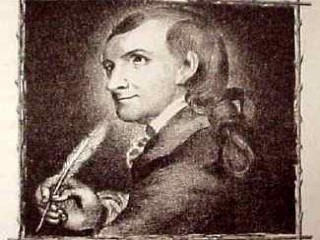
Francis Hopkinson biography
Date of birth : 1737-10-02
Date of death : 1791-05-09
Birthplace : Philadelphia, Pennsylvania
Nationality : American
Category : Famous Figures
Last modified : 2011-05-06
Credited as : Author and composer, signers of the Declaration of Independence,
Francis Hopkinson, the first native American composer, was also a literary satirist, jurist, and inventor.
Francis Hopkinson was born on Oct. 2, 1737, in Philadelphia. He studied at the academy there and then attended the recently opened College of Philadelphia (later University of Pennsylvania), graduating at 19. In 1759 he composed his first song, "My days have been so wondrous free." Hopkinson read law under the attorney general of the Pennsylvania province and was admitted to the bar in 1761. He was a member of an Indian treaty commission in 1765, the same year he translated the Dutch Psalter and opened a conveyance service in Philadelphia. Benjamin Franklin characterized the young dilettante as "very ingenious, " of "good Morals & obliging Disposition." Hopkinson visited Franklin in London in 1766, vainly seeking royal preferment. Back home, he opened a dry-goods shop.
Hopkinson married Ann Borden, of Bordentown, N.J., on Sept. 1, 1768. In 1772 he was an organist at Christ Church in Philadelphia when England's prime minister Lord North appointed him customs collector for Newcastle, Del. Apparently dissatisfied with this position, he moved to Bordentown, resumed practicing law, and in 1774 rose to the governor's council. Also in 1774, he wrote A Pretty Story, a satirical anti-British nursery tale.
In 1776 Hopkinson was sent by New Jersey to the Continental Congress, which made him chairman of the naval board and, later, treasurer of loans. He was a signer of the Declaration of Independence. In 1778 he wrote his famous Revolutionary poem, The Battle of the Kegs, a jeering ballad commemorating a British "victory" over American mines on the Delaware River.
Hopkinson's Temple of Minerva, a gala "oratorical entertainment, " was presented in 1781. His pro-Constitution satire, The New Roof, appeared in 1787. In 1788 he composed his charming book of music, Seven Songs. Also a scientist and inventor, he designed a floating lamp, a spring block to assist sailboats, and a better method of gassing ascension balloons. He is also said to have designed the American flag.
Hopkinson served as an Admiralty judge from 1779 to 1789, when President Washington appointed him a federal judge. He died in Philadelphia on May 9, 1791, survived by his wife and six children.
Hopkinson's Miscellaneous Essays and Occasional Writings (3 vols., 1792) is the basic collection of his literary production. Much of Hopkinson's most engaging writing is found in his correspondence, particularly to Jefferson. The best secondary source is George Everett Hastings, The Life and Works of Francis Hopkinson (1926). It provides a guide to the originals in the Miscellaneous Essays and contains manuscript and published articles not included therein. Benson J. Lossing reprinted the original version of A Pretty Story, retitled The Old Farm and the New Farm: A Political Allegory (1857). O. G. Sonneck, Francis Hopkinson: The First American Poet-Composer (1905), discusses Hopkinson's musical life.
















